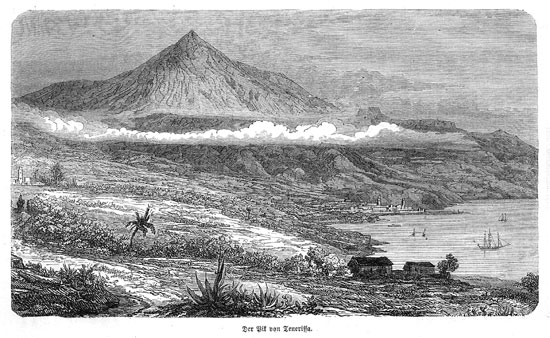According to American biology professor Osvaldo Sala, 20-25% of plant species in the Mediterranean will become extinct by 2050 because of climate change and changes in land use. This is one of the highest levels of predicted biodiversity loses (El Mundo).
Archive for the ‘biodiversity in Spain’ Category
Plant extintion in the Mediterranean
Friday, March 7th, 2008Darwin’s frustrated visit to Tenerife
Tuesday, June 5th, 2007This month’s Quercus has an interesting article on Charles Darwin’s abortive visit Tenerife. Darwin had been inspired to visit El Teide after reading Alexander von Humboldt’s acoount of his ascent of El Teide. This helped fire Charles Darwin with a desire to travel leading him eventually to accept the invitation in 1831 to sail as expedition naturalist aboard the Beagle. The first stage of the Beagle’s voyage was to be stopover for several days at the Canary Islands. Unfortunately, just as they dropped anchor, a boat from the island’s authorities rowed out and informed Captain FitzRoy that they were prevented from going ashore due to a cholera outbreak in England. They were told they would have to wait 12 days in quarantine To Darwin’s dismay Captain FitzRoy gave orders to set sail for the Cape Verde Islands. ” Oh misery, misery we were just preparing to drop our anchor within a mile of Santa Cruz when a boat came alongside bringing with it our death-warrant…..And we have left perhaps one of the most interesting places in the world, just at the moment when we were near enough for every object to create, without satisfying, our utmost curiosity” Darwin’s full description here
 
| “View of the Peak of Teide”. Histoire naturelle des a les Canaries. Les Miscellanes Canariennes. Planches. Webb, P. Barker et Berthelot, Sabin. 1839 |
New species in Spain
Wednesday, February 21st, 200726/11/2006 150 new species are discovered every year in Spain
An interview with Mario GarcÃa ParÃs of the Museo Nacional de Ciencias Naturales in today’s (El Pais) . I paraphrase.
“There are some 60,000 species of animals in Spain, of which some 40,000 are insects. And we are incapable of knowing how many are catalogued. A species is a group of animals which are genetically compatible. There are worms which look the same but are different species and frogs which are as similar as an egg to chestnut tree, but which can breed.
It is impossible to know how many species are still to be recorded. One knows when most of the biological wealth of a country has been recorded when the rate of discovery slows down. This does not seem to be likely in the short term in Spain. We’ve been discovering some 150 new species a year since the late 1970s. And this rate has continued unabated. Since 1978, 3,627 new species have been discovered in the Peninsula, with a further 1,417 in the Canaries at an almost constant rate of 150 a year. “In the distribution maps of species there are dark areas around Madrid, Barcelona and Las Hurdes, in Extremadura. The county of Las Hurdes appears because several people from the museum spend their holidays there”.
There are even big gaps in knowledge with groups such as amphibians despite the legions of amateur naturalists out and about recording them. “A year ago we discovered a new midwife toad which only lives in the fountains of villages. We called it Alytes obstetricans pertynas. “Pertinacious†because while most amphibians are becoming extinct, this one is resisting in human settlements”.
Spain because of its geographical position and the variety of its climate is particularly rich in biodiversity, but much of this being lost. “In the county you can’t hear anything anymore. Ten years ago you heard and saw lots of insects. Now they are spraying everything and all is quiet. When I look at my field notes from 15 years ago describing swarms of bugs I think I must have been exaggerating, but the truth is I was only describing what I saw. When we visit Morocco today we see animals everywhere, just as it was here years ago. If a Goya is burnt. It’s a national tragedy, because it cannot be replaced. The same is true for a species but nobody seems to care”. See also Montseny Brook Newt